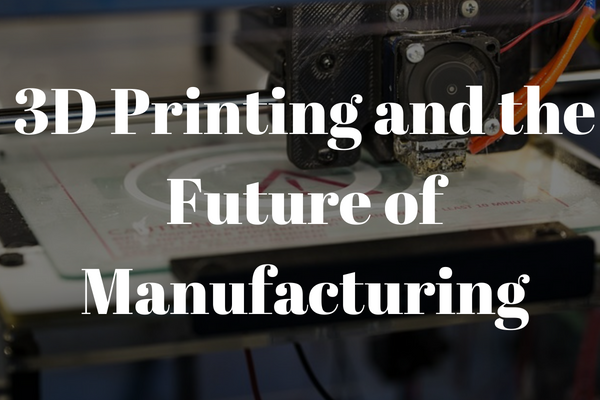
3D Printing and the Future of Manufacturing
Read a summary or generate practice questions using the INOMICS AI tool
3D printing is a technology that has become almost mainstream and is well known to even the casual technology junkie. For the uninitiated, a 3D printer basically works by depositing layers of material to create a component from nothing. This is counter to existing CNC machining, where the process is subtractive in nature and a part is carved out of an existing block of material.
These existing technologies are limited in terms of design flexibility in ways that are completely circumvented with 3D printers. This article aims to shed some light on 3D printing in manufacturing.

Types of 3D Printers
The number of 3D printers on the market can seem overwhelming; just a cursory google search will result in hundreds of different printers. However, this vast array of printers can be broken down into 3 main categories:
- Fused Deposition Modelling (FDM)
FDM is the most common technology in the sphere of 3D printing. These types of printers extrude a thin string of molten plastic in layers until a complete part has been created. The main limitations of this technology are lack of fine detail and the need for support structures to create more complex parts. This is the ideal technology for creating quick and easy protypes for proof of concept.
- Stereo Lithographic Printing (SLA)
SLA is a more advanced technology that works by curing a photo polymer layer by layer to create a part. A cross sectional image of the part is projected onto a plate that is partially submerged in a vat of liquid polymer, this image cures the polymer layer by layer. This method creates extremely high-quality parts. The advantages of SLA are fast printing with a high-quality surface finish. This is ideal for creating demonstration products to show potential clients. Another use is the creation of 3D printed molds for injection molding.
- Selective Laser Sintering/Melting
SLS and SLM are very similar in principle and basically use a laser to melt or sinter powders into final parts. These printers can use a wide range of materials from simple plastics to advanced metal alloys such as Inconel. This technology can be used for creating high quality functional prototypes and in some cases, ready to use and fully functional products.
Suggested Opportunities
- Researcher / Analyst Job
- Posted 5 days ago
Engineer / Applied Physicist in Thermodynamics (TE-CRG-CL-2024-56-LD)
At CERN in Genève, Switzerland- Practitioner / Consultant Job
- Posted 1 week ago
Welding Engineer: General Support (EN-MME-FW-2024-78-GRAP)
At CERN in Genève, SwitzerlandDesign, Prototyping & Manufacturing
Ever since 3d printing has become more mainstream, it has found its way into numerous engineering offices. 3D printing is an extremely efficient way to go from a theory to a prototype in a matter of hours. This eliminates involving too many people who might dilute the initial idea to suit their specific skills and equipment. Adoption of 3D printing as a prototyping tool has increased by 21% from 2017 to 2018. This shows that engineers are realising the usefulness of 3D printing as a design tool.
A 3d printer allows rapid turn around in a design office where parts and assemblies can be printed, tested and iterated upon multiple times in one day. Failed prototypes end up costing only a few cents in raw material. This would not be the case if the prototype was created using traditional techniques. A functional prototype requires expensive machinery and a skilled operator, which adds significant cost.
The risk in creating multiple prototypes in this way tends to place a damper on the creativity of the designer which in turn results in designs that are more conservative and ‘inside the box’. 3D printer prototyping has opened the flood gates of creativity as there is no longer the fear of wasting money on a crazy idea.
Future of 3D Printing
3D printing has come a long way in the last few decades and still has a long way to go. The adoption rates and increased demand for mass manufacture capable 3D printers has driven down the cost of entry level machines, and has allowed smaller companies to benefit from the technology.
3D printing shows significant growth especially in a sector where existing technologies like CNC milling, injection moulding and casting have dominated since the beginning of modern manufacturing. If this growth is anything to go by, additive manufacturing is set to claim a sizeable chunk of the advanced manufacturing pie.
However, this does not mean that existing technology will become obsolete soon. For simple mass-produced parts, traditional techniques like stamping, casting and CNC machining will dominate for some time. In time the cost of the machines and materials will reduce enough to truly make it a universal manufacturing technology.
New materials are constantly being developed as well as cheaper ways to manufacture them. FDM filament is already very cheap, however metal powders have a long way to go to reach true affordability.
3D printing is no doubt the future of manufacturing. All that remains to be seen is the rate with which it becomes the standard technology to manufacture anything from a bolt to a rocket engine nozzle.
Recommended Insights
Top 10 US Master's Programs in Mechatronics
Top 5 Aerospace Companies to Work For
Top 5 Companies for Environmental Engineers to Work For
7 of the Greatest Challenges Engineers Will Face in the Next Decade
-
- Summer School
- Posted 6 hours ago
CEMFI Summer School 2024
Starts 19 Aug at CEMFI in Madrid, Spain
-
- Conference
- Posted 2 months ago
PEGS Boston Summit 2024
Between 13 May and 17 May in Boston, United States -
- Conference
- (Partially Online)
- Posted 2 weeks ago
AI in Business and Economics - The Economic Perspective on Artificial Intelligence (EPEAI)
Between 5 Sep and 6 Sep in Johannesburg, South Africa








